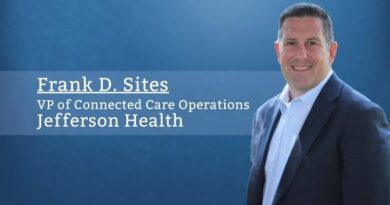Beyond Telehealth: Making Hybrid Care the Standard
By Tania Elliott MD, FAAAAI, FACAAI, Chief Medical Officer, Virtual Care and VP of Clinical and Network Services, Ascension
As leaders in the healthcare industry, providing high-quality care to our patients remains at the forefront of our missions. We strive to keep people healthy, to end needless suffering, and to treat illness. Equally as important is the experience of our clinicians and our patients, enhancing interactions through rapport building, active listening, and shared decision-making incorporated into each encounter.
Today’s world is filled with technology – it’s how we communicate in so many ways. So the question becomes – does every interaction between doctor and patient need to happen in person, in an office? Does there need to be an in-person requirement to ask a patient how they are feeling? To look them in the eyes? To listen to them? To write a prescription? The answer to this question is no, not always. But we do need to assure that the human connection is not lost when interactions are not occurring face to face.
In the United States, physicians are trained on seven core communication competencies:
(1) building the doctor-patient relationship;
(2) opening the discussion;
(3) gathering information;
(4) understanding the patient’s perspective;
(5) sharing information;
(6) reaching agreement on problems and plans; and
(7) providing closure.
We need to ensure that these core competencies are not lost. Instead, they are effectively translated to whatever modality we use to interact with patients, be it in person, through SMS, asynchronous video recordings, or remote monitoring. This will require training of clinicians and non-clinicians alike, and education in our medical schools and residency programs. We also need to acknowledge that with this new world of interaction and information collection through digital data, we must be stewards of patient privacy and security.
Take this opportunity to document and memorialize workflows and processes in your organization – leverage the progress and momentum that occurred during the COVID pandemic.
The COVID-19 pandemic accelerated a growing trend in the usage of telehealth. Seemingly overnight, telemedicine visits spiked across the nation as providers scrambled to find new methods of providing care amid the pandemic. Many organizations witnessed change spurred at unprecedented rates as healthcare staff was forced to change workflows and processes ingrained in daily operations. Years of care delivery advancements took place in only a few short months to meet our patients’ clinical, safety, and access needs. As medical offices and clinics postponed or dramatically reduced care across the country, those that adopted telehealth provided an opportunity to continue care while mitigating physical – and psychological – challenges resulting from the pandemic.
Some do not realize that the definition of telehealth goes far beyond synchronous video or telephone visits, i.e., telemedicine, which is only the tip of the iceberg. Telehealth, or virtual care, is a broad term encompassing a wide spectrum of digital capabilities, including remote physiologic and therapeutic monitoring, e-consultations, digital check-ins, and digital therapeutics, to name a few. These options should be seen as tools that augment the care of patients – not as care alternatives or replacements for traditional care delivery. If there was any silver lining to the pandemic, it was that virtual visits should now be considered a core component of longitudinal care delivery – a routine way in which clinicians interact with their patients.
Take prenatal care, for example. The American College of Obstetrics and Gynecology supports a hybrid care model for prenatal care, where certain visits can be conducted virtually in an effort to “enhance, not replace, the current standard of care”. This reduced the burden of the traditional 11-15 in-person prenatal visits, improved efficiencies by consolidating procedure-based care in-person, and left time for education, providing guidance, and shared decision-making through a virtual visit from the comfort of a patient’s home. The addition of blood pressure and glucose remote physiologic monitoring for high-risk patients could serve as a key quality enhancement to routine prenatal care.
Implementation of hybrid models of care or the addition of new services, including remote patient monitoring, will require change management. There will be different workflows, care teams, clinicians’ expectations, reimbursement structures, and technology requirements. Clinical documentation in EHRs are typically set up for patient encounters and not asynchronous interactions. Data will need to be stored and trended, alerting a clinician only when clinically appropriate. There will be an opportunity for higher engagement with patients. Still, the role of the physician and other care team members, the frequency of digital interactions, video interactions, and in-person care will need to be better defined. We should advocate for new funding opportunities and grants to test out hybrid care programs, allowing all healthcare systems – regardless of size and resources – to take the leap into hybrid care, test, iterate, and learn.
It’s pivotal to ensure virtual care results in equitable access and does not further the digital divide. Meeting people where they are is perhaps one of the biggest benefits provided via virtual care. A 2018 Cedars Sinai study showed that a pharmacist-led, barbershop-based medical intervention could successfully lower blood pressure in high-risk African-American men. Coupled with synchronous or asynchronous physician visits, such programs have significant potential to reach underserved communities. Programs can be simple – a connected tablet in a homeless shelter or a virtual visit “office” in a public library can allow for equitable access and support the bridging of health disparities.
As healthcare leaders in the post-COVID era, we have a great opportunity to advance the adoption of virtual care across all facets of healthcare. Take this opportunity to document and memorialize workflows and processes in your organization – leverage the progress and momentum that occurred during the COVID pandemic. Explore new opportunities for telemedicine and digital health, including emerging fields such as remote patient monitoring. And, on a more global basis, monitor policy developments and advocate to support ongoing access to virtual care. Together, we can ensure virtual care becomes a key component of providing high-quality care to the patients we serve, wherever they are.



